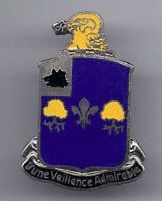39th Infantry Regiment
– “The Fighting Falcons” –
Origin and World War I:
The 39th Infantry Regiment was activated on June 1st, 1917, at Camp Syracuse in New York.
On July 18th, 1918, the 39th Infantry Regiment participated with the American Expeditionary Force and joined battle for the first time during World War I in the now famous “Aisne-Marne Offensive” which was destined to swing the fortunes of war in favor of the Allies. When the smoke of World War I cleared away, the 39th Infantry Regiment’s colors showed battled honors for the campaigns of the Aisne-Marne, Meuse-Argonne, Lorrain, St Mihiel and Champagne, a Distinguished Unit Citation from the grateful French government and the French Croix de Guerre with Gold Star. The Regiment returned home in 1919 and was deactivated in 1921.
World War II:
The 39th Infantry Regiment became a part of the 9th Infantry Division when the Division was reactivated at Fort Bragg, North Carolina, on July 20th, 1940. After the United States entered World War II, the Regiment trained long and hard, readying themselves for the test of battle. The first Combat unit of American troops to set foot on foreign (though friendly), soil in Europe in World War II, were members of the 39th Infantry Regiment. The Regiment landed on October 17th, 1942 at Inverary in Scotland.
Soon the 39th Infantry Regiment had a mission: Securing the northern coast of Africa and thereby safeguarding the Mediterranean link in the Allied lifeline to the Middle and Far East. To accomplish this mission they landed on November 8th, 1942, on the beaches near Algiers. Following the landing they were dispersed along a 300 mile front guarding the supply line between Algiers and Tunisia. The 39th took a decidedly more active role in the war when they were deployed east of the famed “Kasserine Pass” as a covering force for the 1st Armored Division. This was followed quickly by successive battles in the final drive to Bizerte. The Regiment plated a leading role in this action and brought the German Panzer Armee – Afrika to its knees and winning control of North Africa. Sicily loomed on the horizon for the “Fighting Falcons”, their nickname. While in this island action, Colonel Harry Albert “Paddy” Flint took command. This legendary hero of the Regiment gave it the slogan “Triple A Bar Nothing” or “Triple A Bar None”. The “Anything, Anytime, Anywhere Bar Nothing” Regiment immediately put the slogan to work with 8 days of ferocious fighting for Troina, the hub of the German defenses in Sicily. The letters “-A-A-A-O-” can often be seen painted on the helmets of the 39th Infantry Regiment soldiers as a tribute to the slogan, and their Commander Paddy Flint.
By November 11th, 1943, the 9th Infantry Division, including the 39th Infantry Regiment, was on the high seas bound for England and more intensive training in preparation the Normandy Invasion. On D-Day plus 4, June 10th, 1944, the Regiment landed at Utah Beach. On June 12th, the 9th Infantry Division began a series of battles which resulted in the race to the sea and the eventual sealing off of the Cherbourg Peninsula. The battle for the Contentin Peninsula began on June 18th, 1944. Again, the 39th Infantry Regiment excelled, this time in Anderville, which fell on July 1st, yielding 3.000 prisoners. Next followed the famous “Battle of the Hedgerows”, the large earth walls covered with large bushes and trees, dividing the many farming fields in Normandy. For 25 days the men of the Fighting Falcons fought, bled and died in of the bloodiest battles of all time. After the St. Lo breakthrough, the 39th Regiment raced across France, tangling with the retreating Germans at every town and crossroads where the Germans choose to stand and fight.
By August 19th, 1944, the 39th Regiment was posed for the drive to the Seine River and Paris. By the 26th of August, the Seine River was reached. The 39th then moved north-eastward and sealed off the Mons Pocket. It then wheeled eastward into Belgium. On September 13th, 1944, the 39th Regiment swept forward to begin a long and costly drive through the Hurtgen Forest in Germany. It moved past the Dragon Teeth (anti-tank constructions made out of cement blocks) and closed in on the fortified town of Roetgen, Germany. On September 14th, the town fell to the 39th and would be the first German city captured in World War II. Day by Day throughout the rest of September, October and the first week of November, the 9th Infantry Division battled its way through the Hurtgen Forest. These were terrible fights, and often named the “worst of all battles” according to many veterans of this Division. On November 16th the Division started a campaign to close up the left bank of the Roer River. This was finally accomplished on December 16th, 1944. By New Year’s Day, 1945, the 39th Regiment and all of the 9th Infantry Division were on the move again.
By the end of January the Division was spearheading the drive across Germany to the Rhine River. The 39th Regiment reached the Rhine on the morning of March 7th, 1945. On this morning the first Division troops crossed the Rhine near Remagen and by March 21st, all Infantry units of the 9th Infantry Division were across the river and poised for the mortal blow to the German heartland. Forging east and then north during April, the Fighting Falcons fought into the Harz Mountains and the Ruhr Pocket. The days wore on until May 8th, 1945, when Victory in Europe was gained!
